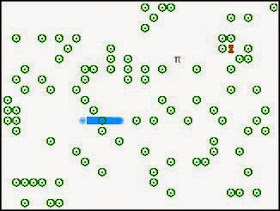Some calculator art done this week:

Eye Parametric Pattern
HP Prime:
App: Parametric
Range: Autoscale, -2.85349369234 ≤ T ≤ 2.85349369234
Equations:
X1(T) = T
Y1(T) = -0.1736934*T^2 + 1.4142857
X2(T) = T
Y2(T) = -0.1736934*T^2 - 0.587143
X3(T) = T
Y3(T) = -Y1(T)
X4(T) = T
Y4(T) = -Y2(T)
X5(T) = 0.1736934*T^2 - 1.4142857
Y5(T) = T
X6(T) = -X5(T)
Y6(T) = T
X7(T) = 0.17356934*T^2 + 0.5857143
Y7(T) = T
X8(T) = -X7(T)
Y8(T) = T

Hilly Yard
HP Prime
App: Parametric
Range: -2 π ≤ T ≤ 2 π , Radians Mode
Equations:
X1(T) = T
Y1(T) = PIECEWISE(-2 π ≤ T < -1.5 π, 2T/π + 4,
-1.5 π ≤ T < -0.5 π , -2T/π - 2,
-0.5 π ≤ T < 0.5 π, 2T/π,
0.5 π ≤ T < 1.5 π, -2T/π + 2,
1.5 π ≤ T ≤ 2 π, 2T/π -4)
Color: Orange
X2(T) = T
Y2(T) = sin T
Color: blue
X3(T) = PIECEWISE(-1 ≤ T ≤ 1, -π/2)
Y3(T) = PIECEWISE(-1 ≤ T ≤ 1, T)
Color: Green
X4(T) = PIECEWISE(-π/2 ≤ T ≤ π/2, T)
Y4(T) = PIECEWISE(-π/2 ≤ T ≤ π/2, T/π + 3/2)
Color: Green
X5(T) = 0.15 cos T + π/2
Y5(T) = 0.15 sin T + 2
Color: Red
X6(T) = cos(27*T) sin T + π/2
Y6(T) = cos(27*T) cos T + 2
Color: Red.

The Shield
Casio Prizm
Mode: Graphing
Window:
X = [-3.5, 3.5], Y = [-0.1, 4.5], Range: -2 ≤ T ≤ 2
Equations (Shield):
X1(T) = T
Y1(T) = -0.3125 T^2 + 4.25
X2(T) = T
Y2(T) = 3 T^2 ÷ 4
X3(T) = T
Y3(T) = -0.125 T^2 + 3.5
The arrow was drawn with the FreeLine command.

Flowers
HP Prime:
App: Advanced Graphing
Radians Mode, Autoscale
Equations:
V1: √(X^2 + Y^2) ≤ 2 cos (24 atan(Y/X))
Color: Red
V2: √(X^2 + Y^2) ≤ 2.5 cos (4 atan(Y/X))
Color: Green
V3: √(X^2 + Y^2) ≤ 2.5 cos (4 (atan(Y/X) - π/4)
Color: Green.

Circlegraph
Casio Prizm
Program:
PROGRAM DRAWCIR
Cls
-10 →Xmin
10 → Xmax
-10 → Ymin
10 → Ymax
For 0 → I To 2 π Step π ÷ 8
Plot/Line Color Blue
Circle 5 cos I, 5 sin I, 2
Plot/Line Color Green
Circle 5 cos I, 5 sin I, 1
Next
Plot/Line Color Yellow
Circle 0,0,5
This blog is property of Edward Shore. 2014













